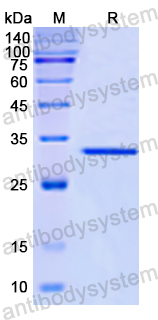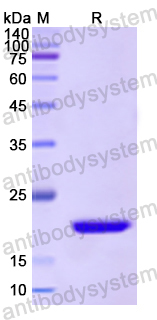Catalog No.
YHE67901
Expression system
E. coli
Species
Homo sapiens (Human)
Protein length
Met1-Arg53
Predicted molecular weight
32.73 kDa
Nature
Recombinant
Endotoxin level
Please contact with the lab for this information.
Purity
>90% as determined by SDS-PAGE.
Accession
P49682
Applications
ELISA, Immunogen, SDS-PAGE, WB, Bioactivity testing in progress
Form
Lyophilized
Storage buffer
Lyophilized from a solution in PBS pH 7.4, 0.02% NLS, 1mM EDTA, 4% Trehalose, 1% Mannitol.
Reconstitution
Reconstitute in sterile water for a stock solution. A copy of datasheet will be provided with the products, please refer to it for details.
Shipping
In general, proteins are provided as lyophilized powder/frozen liquid. They are shipped out with dry ice/blue ice unless customers require otherwise.
Stability and Storage
Use a manual defrost freezer and avoid repeated freeze thaw cycles. Store at 2 to 8°C for frequent use. Store at -20 to -80°C for twelve months from the date of receipt.
Alternative Names
CXCR3, G protein-coupled receptor 9, CXC-R3, Interferon-inducible protein 10 receptor, IP-10 receptor, C-X-C chemokine receptor type 3, GPR9, CD183, CKR-L2, CXCR-3
FGFR4 promotes CAF activation through the CXCL10-CXCR3 axis in colon cancer., PMID:40447617
The Influence of an Acute Endurance Intervention on Breast Cancer Cell Growth-A Pilot Study., PMID:40362215
Novel Link Between Myeloid-Specific Adenosine Deaminase 2 and CXCL10-CXCR3 Axis in Infectious ARDS., PMID:40332245
Development of DPP-4-resistant CXCL9-Fc and CXCL10-Fc chemokines for effective cancer immunotherapy., PMID:40238455
The immunosuppressive role of neutrophils in infectious and oncological conditions: A study of chemokine receptor CXCR3 and human neutrophil lipocalin levels., PMID:40200380
Cxcr3 promotes protection from colorectal cancer liver metastasis by driving NK cell infiltration and plasticity., PMID:40168086
The CXCR3/PLC/IP3-IP3R axis is responsible for the ignition of UPR in intestinal epithelial cells exposed to gliadin peptide, during the onset of celiac disease., PMID:40165272
Reconstitution of CXCR3+ CCR6+ Th17.1-Like T Cells in Response to Ofatumumab Therapy in Patients With Multiple Sclerosis., PMID:40164501
[Expression and clinical significance of CXCR3 on effector T cells in the peripheral blood of patients with Alzheimer's disease]., PMID:40159070
Structural visualization of small molecule recognition by CXCR3 uncovers dual-agonism in the CXCR3-CXCR7 system., PMID:40155369
Higher proportions of circulating CXCR3+ CCR6- Tfh cells as a hallmark of impaired CD4+ T-cell recovery in HIV-1-infected immunological non-responders., PMID:40130906
Curcumin inhibits ferroptosis-mediated vascular occlusion by regulating the CXCL10/CXCR3 axis in retinopathy of prematurity., PMID:40128669
Understanding the pleiotropic effects of CXCL10/IP-10 in the immunopathogenesis of inflammatory rheumatic diseases: Implications for better understanding disease mechanisms., PMID:40121742
Evaluation of peripheral NK tests offered to women with recurrent pregnancy loss and a search for novel candidate biomarkers., PMID:40112444
ApoE ε4-dependent Alteration of CXCR3 + CD127+ CD4+ T cells associates with elevated plasma neurofilament light chain in Alzheimer's disease., PMID:40112322
T-bet+ CXCR3+ B cells drive hyperreactive B-T cell interactions in multiple sclerosis., PMID:40107244
Unveiling the key mechanisms of FOLR2+ macrophage-mediated antitumor immunity in breast cancer using integrated single-cell RNA sequencing and bulk RNA sequencing., PMID:40045365
Migration arrest and transendothelial trafficking of human pathogenic-like Th17 cells are mediated by differentially positioned chemokines., PMID:40000641
Enhanced CXCL10 expression in mast cells for cutaneous neurofibroma presenting with pain and itch., PMID:39979642
Oral Cancer-Derived miR-762 Suppresses T-Cell Infiltration and Activation by Horizontal Inhibition of CXCR3 Expression., PMID:39940842
Activation of CXCR3+ Tfh cells and B cells in lymph nodes during acute HIV-1 infection correlates with HIV-specific antibody development., PMID:39932316
Novel Therapeutic Approach Targeting CXCR3 to Treat Immunotherapy Myocarditis., PMID:39931812
Functional validation of a novel STAT3 'variant of unknown significance' identifies a new case of STAT3 GOF syndrome and reveals broad immune cell defects., PMID:39836489
Preliminary exploration of the association of CXCR6+T lymphocytes in T2D., PMID:39798468
Immunohistochemical evaluation of LGR5, CD71, CD138 and CXCR3 markers in the small bowel mucosa of participants with celiac disease and persons with normal bowel mucosa., PMID:39747719
Immune checkpoint inhibitor-induced severe epidermal necrolysis mediated by macrophage-derived CXCL10 and abated by TNF blockade., PMID:39737932
Blocking CXCR3B Expression Increases Tumor Aggressiveness in Hepatocellular Carcinoma., PMID:39626933
The USP35-CXCR3 Axis plays an oncogenic role in JeKo-1 mantle cell lymphoma cells., PMID:39591978
Role of PD-1 in modulating IFN-γ-CXCL9/10-CXCR3 signaling in breast cancer., PMID:39588744
Renal remodeling by CXCL10-CXCR3 axis-recruited mesenchymal stem cells and subsequent IL4I1 secretion in lupus nephritis., PMID:39557841
CCR8/CCL1 and CXCR3/CXCL10 axis-mediated memory T-cell activation in patients with recalcitrant drug-induced hypersensitivity., PMID:39503255
[Analysis of Frequencies and Subsets of Peripheral Helper T Cells in Patients with Immune Thrombocytopenia]., PMID:39479841
Increased splicing of CXCR3 isoform B (CXCR3B) by impaired NRF2 signaling leads to melanocyte apoptosis in active vitiligo., PMID:39471971
The Role of CXCR3 in Nervous System-Related Diseases., PMID:39429695
The Expression pattern of NK cells in systemic lupus erythematosus patients with different disease activities., PMID:39427243
CXCR3-CXCL11 Signaling Restricts Angiogenesis and Promotes Pericyte Recruitment., PMID:39360413
Multidimensional profiling of human T cells reveals high CD38 expression, marking recent thymic emigrants and age-related naive T cell remodeling., PMID:39321807
Blood immune profiles reveal a CXCR3/CCR5 axis of dysregulation in early sepsis., PMID:39312202
NKG2C and NKG2A coexpression defines a highly functional antiviral NK population in spontaneous HIV control., PMID:39288262
Phenotypic profiling of human induced regulatory T cells at early differentiation: insights into distinct immunosuppressive potential., PMID:39264416
Astragalus polysaccharide enhances antitumoral effects of chimeric antigen receptor- engineered (CAR) T cells by increasing CD122+CXCR3+PD-1- memory T cells., PMID:39243425
CXCR3-Expressing T Cells in Infections and Autoimmunity., PMID:39206903
Cytotoxic T cells drive doxorubicin-induced cardiac fibrosis and systolic dysfunction., PMID:39196030
Interleukin-6 positively correlates with cardiovascular disease predictor algorithms and biomarker in rheumatoid arthritis patients., PMID:39160453
Prognostic role of chemokine-related genes in acute myeloid leukemia., PMID:39135956
Expression patterns of immune checkpoint proteins and Plasmodium falciparum-induced cytokines in chronic hepatitis B virus-infected and uninfected individuals: A cross-sectional study., PMID:39086506
Methazolamide Can Treat Atherosclerosis by Increasing Immunosuppressive Cells and Decreasing Expressions of Genes Related to Proinflammation, Calcification, and Tissue Remodeling., PMID:39081633
The transcriptional repressor B cell lymphoma 6 regulates CXCR3 chemokine and human leukocyte antigen II expression in endothelial cells., PMID:39074669
Regulatory T and CXCR3+ Circulating Tfh Cells Concordantly Shape the Neutralizing Antibody Responses in Individuals Who Have Recovered from Mild COVID-19., PMID:39052730
Varied immune responses of HBV-specific B cells in patients undergoing pegylated interferon-alpha treatment for chronic hepatitis B., PMID:38992769


